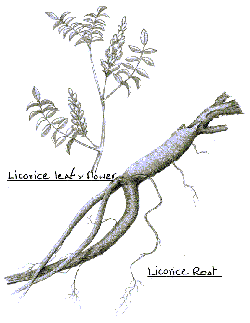 |

LICORICE ROOT: A BIOLOGICALLY ACTIVE HERB
Licorice was
brought to my attention by Candy, who works at Pacific Coast Greens,
a great health food store in Malibu. I've done some research on
it, using myself as a guinea pig. I found licorice to be a wonderful
herb, for it does away with all sorts of uncomfortable nuisances,
including high temperature, ulcers, and arthritis.
Dan Mowrey states:
|
Licorice
root is one of the most biologically active herbs in the world.
Licorice root is an effective treatment for stomach ailments,
because it exerts a soothing action on the muscosal surfaces
of the GI tract, and it is frequently used to help these tissues
heal. The licorice root derivatives, glycryuhetinic acid (GLA),
deglycrihyinated licorice (DGL), and carbenoxolene sodium
(CS) have all been proven to be among the best anti-ulcer
medications available. Whole licorice and its derivatives
appear to have the ability to inhibit gastric acid secretion
with the advantage of being devoid of other adverse anti-cholinergic
properties.
Licorice
root helps prevent and heal skin problems. The conditions
that increase the occurrence of acne-like symptoms during
certain stages of the menstrual cycle may be affected by the
consumption of licorice root.
The anti-inflammatory
properties of the root have been considered responsible for
its effectiveness in the treatment of numerous skin disorders,
including eczema, dermatitis, impetigo, and traumatized skin.
It should
be mentioned that the antipyrelic (fever reducing) effects
of GLA have been shown to be equal to those of the widely
used sodium salicylate. (48)
|

Fever reduction
is important to hepatitis C patients. My experience for several
years was that I was always at about 99.8 degrees. My fever would
rise after eating. It was extremely uncomfortable to live day after
day, year after year, just a little bit hot.
Every time a
doctor would record my slightly elevated temperature, I would ask
why it was high. The usual answer was, "you probably just have a
bug." Taking licorice really helped this problem.
Licorice root
is used to remove buildup of toxic metabolic substances in the body,
because it increases the liver's ability to filter out these wastes.
In the treatment
of liver diseases (e.g. hepatitis and cirrhosis), GLA has proven
extremely promising. In Chinese medicine, licorice is often used
as a remedy for jaundice and is considered a great liver detoxifier.
According to Dan Mowry:
| Experimental
work has validated the usefulness of licorice in the treatment
of hepatitis, cirrhosis, and related liver disorders. Licorice
is a good tonic for the adrenal glands and Addison's disease.
|
This is very
important for the hepatitis C patient because you need to support
your adrenal gland in many ways in order to conquer the virus.
Mowrey continues:
|
Licorice
appears to both mimic and potentiate the action of the adrenal-caiticosteroids,
though it also differs in action from these chemicals in several
important ways.
Licorice
components have been found to exert a positive effect on the
course of several adrenal insufficiencies, even in Addison's
Disease, which is characterized by near total adrenal exhaustion.
|
In later stages,
the hepatitis C patient may develop severe joint pain, which I did.
This pain was compounded one hundred fold by interferon. Mowrey
writes:
|
The anti-arthritic
properties of GLA and the aqueous extracts of licorice have
also been shown. Comparisons of licorice root to hydrocortisone
are frequently made in the medical literature in England,
China, and countries other than the USA
In relation
to the immune system, (which hepatitis C patients must become
obsessed with boosting), licorice root and its derivatives
have recently shown extremely promising results as interferon
inducers, which is especially good news for the treatment
of hepatitis C. (When was the last time your hepatitis C doctor
told you that)?
At concentrations
well tolerated by uninfected cells, glycyrhezic acid inhibits
both growth and cytopathic effect of vaccinia, as well as
herpes simplex, Newcastle disease, and vesicular stomatits
viruses while being ineffective on polio virus.
|
It is suggested
that glycyrhezic acid interacts with virus structures (conservable
proteins) producing different effects according to the viral stage
affected: inactivation of free virus particles extracellularly;
prevention of intercellular uncoating of infecting particles; impairment
of the assembling ability of virus structural components. Dr. Mowry
further states:
| As
a general cautionary measure, persons with a history of hypertension,
renal failure, or who are currently using cardian glycosides
may wish to avoid the use of licorice root altogether. |
During my
treatment I took:
One 500 mg. licorice capsule two times per day, five days a week.
I also drank two cups of licorice tea five days a week.

|

